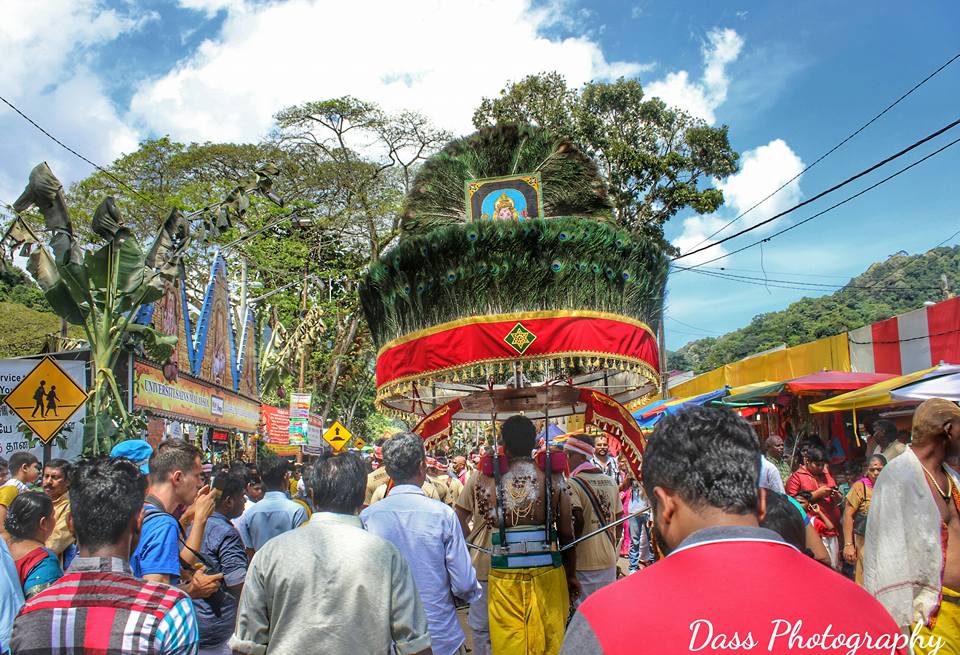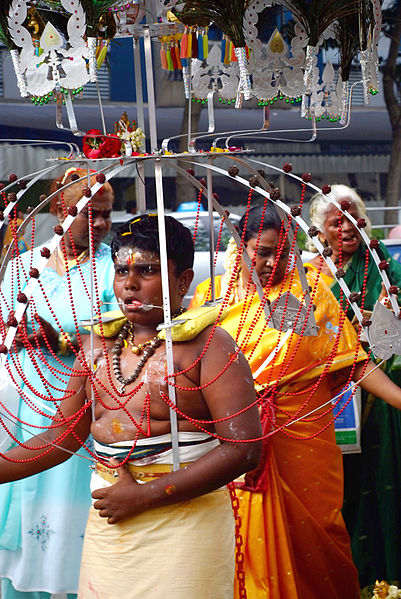Table of Contents
TogglePractical Tips & Guide to Attending Thaipusam Procession in Malaysia
Joining the Thaipusam celebration in Malaysia is a captivating and spiritually enriching experience. Thaipusam, an important Hindu festival, is celebrated with great fervor, with over a million devotees taking to the street in an awe-inspiring kavadi procession, as a symbolic act of penance and gratitude to Lord Murugan.
Visitors can witness not only the devout fulfilling their vows but also partake in the vibrant cultural performances, delicious traditional food, and the general sense of unity that permeates the air. Here’s a comprehensive guide to help you experience this iconic Hindu celebration.
What is Thaipusam?
Thaipusam is a Hindu festival that is widely celebrated by the Tamil community, primarily in South India, Sri Lanka, Malaysia, Singapore, and other places with a significant Tamil population. The festival is dedicated to Lord Murugan, also known as Subramanya, Kartikeya, Shanmukha, or Skanda, who is revered as the God of War and Victory in Hinduism.
Thaipusam’s roots trace back to ancient Tamil Nadu, India, where it commemorates Murugan’s mother Parvati giving him a spear to defeat the demon.
The word “Thaipusam” is derived from the Tamil month of “Thai,” which usually falls in January or February, and “Pusam,” which refers to the star Pushya that is at its highest point during this festival.

The main highlight of Thaipusam is the kavadi procession, where devotees carry a physical burden, known as a kavadi, as an offering to Lord Murugan. The kavadi is often a structure that includes a framework decorated with various materials like flowers and peacock feathers. It is believed that those who carry the kavadi during Thaipusam will have his life burdens lessened by Lord Murugan.
The core of this celebration is to seek forgiveness for your sins. To do that, devotees will often relinquish certain comforts in their daily lives or perform certain acts such as piercing their bodies with hooks, skewers, or small lances as a form of penance and to demonstrate their devotion.
When is Thaipusam Celebrated?
Thaipusam is typically celebrated during the full moon of the Tamil month of Thai, which falls between January and February in the Gregorian calendar. The exact date varies each year based on the lunar calendar.
This year, the Thaipusam festival falls on 25th January 2024. In many states in Malaysia, Thaipusam is a public holiday. While it is only marked as a one-day public holiday, the actual festival takes place over four days.
Where to Celebrate Thaipusam in Malaysia
Kuala Lumpur
In Malaysia, the epicenter of Thaipusam celebrations is at the Batu Caves near Kuala Lumpur. The procession starts at Sri Maha Mariamman Temple — the oldest Hindu temple in Kuala Lumpur and ends at Batu Caves.
The limestone caves provide a stunning backdrop for the festivities. The base of the caves is unmistakably marked by the world’s tallest statue of Lord Murugan. Standing at a height of 42.7 meters, this golden tribute to the Hindu deity is constructed from 1,550 cubic meters of concrete, 250 tonnes of steel bars, and coated with 300 liters of gold paint.
Devotees embark on a pilgrimage up the 272 steps to reach the temple inside the caves.

Penang
The Thaipusam procession commences at the Sri Mahamariamman Temple, the oldest Hindu temple in Penang, and concludes at the Arulmigu Balathandayuthapani Temple. After traversing the historical streets of Georgetown, worshippers face the significant challenge of ascending 513 steps to reach the intricately adorned sanctuary at the summit.
Fondly referred to as the Waterfall Hill Temple, the Arulmigu Balathandayuthapani Temple is recognized as the largest Murugan temple outside India, spanning an impressive 70,000 square feet.
Beyond the Tamil community, individuals of various ethnicities, particularly the Chinese, participate in the procession, carrying the kavadi to seek blessings from Lord Murugan.

Ipoh
In Ipoh, the Thaipusam celebrations start with a procession from the Sri Maha Mariamman Temple in Buntong and conclude at the Kallumalai Arulmigu Subramaniar Temple at the base of Gunung Cheroh, next to the Kinta River.
The initial structure of the temple was constructed within a limestone cavern. However, due to an unfortunate incident, the decision was made to build the current structure away from the cave.
While not as elaborate as Batu Caves, the Kallumalai Arulmigu Subramaniar Temple remains dedicated to South Indian traditions. At the rear of the temple, there is an enclosure for peacocks

Johor
In Johor, the celebration takes place at Muniswarar Temple, which serves as both the beginning and concluding point. Devoted to Muniswarar, a highly esteemed family deity, the inner sanctum of the temple is visually stunning, featuring walls adorned with gold. It is recognized as the most ancient Hindu temple in Johor, and becomes a bustling center of activity during Thaipusam.
The elaborate design has led some individuals to draw comparisons with the natural splendor of Batu Caves, and the resemblance is evident.

How is Thaipusam Celebrated in Malaysia?
The Preparation
The preparations commence 48 days (equivalent to one mandala) prior to the Thaipusam festival. Devotees undergo a process of purification, eliminating both mental and physical impurities through observed austerities, which include:
- Exercising control over the senses.
- Engaging in complete fasting or consuming only a simple vegetarian meal or fruits and milk each day.
- Abstaining from smoking cigarettes, alcohol, or any other intoxicants.
- Taking cold water baths.
- Practicing celibacy.
- Men typically refraining from shaving or cutting their hair during this period.
- Sleeping on the floor.
- Performing constant or at least morning and evening poojas, prayers, chanting, hymn-singing, reading of spiritual books, and contemplation on Lord Murugan.
On Thaipusam Eve

Upon fulfilling the 48-day purification, devotees are required to undergo a complete fast in the 24 hours leading up to Thaipusam. Some individuals might additionally choose to observe a vow of silence.
Following a purifying bath and adorned in appropriate attire, they proceed to the Murugan temple, bearing their offerings. Since many devotees opt to walk barefoot, procession will be long and slow.
In Kuala Lumpur, the procession typically starts at around 10 pm on the eve and is expected to reach its destination at 2 pm the next day. Certain roads will be closed for a few days to make way for the procession.
Those who carry the kavadi will be put in a trance-state by priests. Their shirtless bodies will be slathered with holy ash and sandal paste.
They will then be accompanied by other devotees who will sing devotional songs, chant mantras, and play traditional musical instruments, creating a lively but spiritual atmosphere.
On Thaipusam Day
While some devotees have started the procession the night before, some may only join in the celebration on the day of Thaipusam itself. Before heading to the temple, male worshippers can shave their head and beards, and take a ritual bath.
Apart from kavadi, bringing offerings to the temple is also an important part of Thaipusam celebrations. Items that are traditionally brought as offering include flowers, sweet fruits, coconuts, rose water, and milk in metal urns that they will carry above their heads.

Another common ritual is the smashing of coconuts on the ground. In Hindu culture, the coconut holds sacred significance, believed to be the purest form of offering.
The tough outer shell symbolizes the physical aspect of man, the inner white fruit represents the psychological, and the untouched sweet water inside represents the spiritual. Smashing the coconut serves as a symbol of breaking the ego to reveal the inherent purity within.
Take a close look at the kavadi bearers if you can. Apart from their courage and determination, you will also be amazed by the teamwork demonstrated by their group of supporters. One individual may carry a chair that is promptly unfolded whenever the bearer requires rest, another might offer water or assist in wiping away sweat, while the rest could be engaged in playing traditional music or dancing.
Once they are done climbing the steps and presenting the kavadi, a priest will pour hot ashes over the wounds to prevent scars. This will then be followed by more celebrations and merrymaking.
Practical Tips for First Timers
Celebrating Thaipusam in Malaysia offers a profound cultural and spiritual experience. By being prepared and respectful, you can ensure a smooth experience, allowing you to enjoy your time without causing any disrespect to others.
What to Wear to a Thaipusam Celebration

Wear modest clothing that goes below the knees, and consider bringing a scarf or shawl to cover your shoulders when entering religious areas. To stay comfortable in the heat, wear something light, loose, moisture-wicking, and quick-drying.
Yellow and orange are the preferable colors for Lord Murugan, as they represent happiness, peace, and a new beginning. Black and dark colors are considered inauspicious. Because this festival is to celebrate Lord Murugan, symbols or paraphernalia representing other deities are not allowed. Visitors must not wear anything bearing the symbol of a gang, swastika, or other religions or faiths, or any indecent images or texts.
Footwear has to be removed before entering temples, so wear something that is easy to remove and put back on.
How to Get to Batu Caves
Traffic around Batu Caves can be heavily congested during Thaipusam, and some roads are closed to make way for the procession. Public transportation may be your best option during this festival. The KTM Komuter, the local train service that has a station right next to the caves, are available 24 hours for four days, and with increased frequencies for the festival.
This year, the commuters traveling to and from Batu Caves during the festival can ride the train for free. Click here to check the train schedule, and try to arrive early if you can. The sooner you reach the Batu Caves, the better, preferably before sunrise. The train journey from Kuala Lumpur to Batu Caves takes around 35 minutes.
Dealing with the Crowd

Thaipusam attracts a large crowd, which can be overwhelming, especially in the heat. Make sure you bring enough water and snacks, as the festivities can last for hours. Stay hydrated, especially if you plan to climb the stairs to Batu Caves.
Be cautious of pickpocketing and potential stampedes in the crowded areas. If climbing all the way upstairs seems too much due to the crowd, consider exploring the surrounding areas. Take time to visit the many food stalls and indulge in the festival’s delicacies.
Public toilets are available at several convenient locations. Bring your own toilet paper, wet wipes, and hand sanitizers.
Even though the crowd is enormous, the attendees are generally well-behaved and orderly. Simply go along with the flow, practice patience, and stay vigilant regarding your surroundings.
Stay Respectful

All devotees and visitors are required to respect Thaipusam as a religious festival.
Frivolity, excessive public display of affection, quarreling, fighting, touting, gambling, consumption of drugs or alcohol, and any other acts of nuisance and crime are strictly prohibited in the temple and surrounding areas.
Other secular activities like singing or dancing to modern, non-religious music are also not permitted.
While photography is allowed everywhere inside the caves and temples, do practice respectful photography. Seek permission before taking photographs of individuals, particularly devotees engaged in religious practices.
Avoid consuming non-vegetarian within the temple premises. And lastly, keep the area clean. Throw your rubbish in designated areas.
Final Thoughts
Thaipusam is not only a religious event but also a cultural and social gathering that fosters a sense of community among the participants. It is a time for reflection, penance, and expressing gratitude to Lord Murugan for blessings and favors granted.
Celebrating Thaipusam in Malaysia is a unique opportunity to witness the deep spirituality and rich cultural heritage of the Tamil community in the country while being immersed in the colors, sounds, and fervent energy that define Thaipusam.
Have you experienced the Thaipusam festival in Malaysia? What was it like? Share in the comment section below.